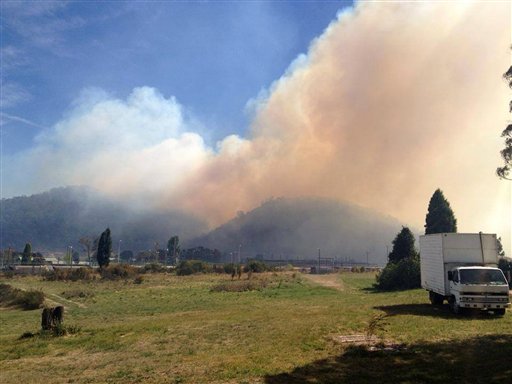Parts of Australia facing worst bushfire threat in 40 years

In this photo provided by the New South Wales Rural Fire Service, smoke rises from a fire near Lithgow, west of Sydney, Thursday, Oct. 17, 2013. Nearly a hundred wildfires are burning across Australia’s New South Wales state, more than a dozen of which are out of control, as unseasonably hot temperatures and strong winds fanned flames across the parched landscape. (AP Photo/New South Wales Rural Fire Service)
SYDNEY- Australian fire services warned Sunday that parts of New South Wales were facing the most dangerous combination of warm, dry weather and strong winds in more than 40 years as major wildfires swept the state.
Fire crews ramped up containment efforts around several of the blazes with the weather forecast to deteriorate and officials warning of “unparalleled” dangers.
More than 200 homes have already been destroyed and another 120 damaged by the wildfires, which broke out across New South Wales state in unseasonably warm weather earlier this week, fanned by extremely high winds.
The worst of the fires, in the Blue Mountains west of Sydney, plunged the city last week into an eerie midday darkness as plumes of smoke and ash filled the sky.
One man has died so far trying to protect his property.
Article continues after this advertisementFirefighters had a reprieve on Friday and Saturday with an easing in the weather, but containment and property protection efforts were stepped up on Sunday ahead of an expected intensification in weather conditions set to include warmer temperatures and 100 kilometer per hour (60 mile per hour) winds.
Article continues after this advertisementNew South Wales Rural Fire Service Commissioner Shane Fitzsimmons said there would be several extremely difficult days ahead for fire crews.
“We’ve got what would be unparalleled in terms of risk and exposure for the Blue Mountains and Hawkesbury communities throughout this week,” Fitzsimmons told reporters.
“If you are to draw a parallel, and it’s always dangerous to draw a parallel, at best you’d be going back to time periods in the late 60s.”
“The reality is, however, these conditions that we’re looking at are a whole new ball-game and in a league of their own.”
State premier Barry O’Farrell said crews had carried out controlled burn operations through the night to strengthen buffer zones around the major Blue Mountains fires and “are on alert to switch to active firefighting if properties come under threat”.
A total fire ban was in place in the Greater Sydney and three other regions across the state until further notice.
An emergency warning was issued for the Blue Mountains village of Bell on Sunday morning, with residents urged to evacuate, if they were able, or to “take shelter in a solid structure when the fire front arrives”.
Villagers in Mount Wilson and Mount Irvine were ordered to bunker down in their homes because it was “not safe to leave” with fire cutting off access roads, while residents of nearby Bilpin were warned if they did not evacuate they could be isolated, without power, for several days.
Assistant police commissioner Alan Clarke said mandatory evacuation orders would be enforced in some areas, describing the risk as “far more extreme” than in past fires.
“Police will be doing forced evacuations if the risk is necessary,” Clarke told reporters.
“At the end of the day we hope we have buildings standing, but if we don’t have buildings standing we don’t want bodies in them.”
“It’s important to understand that the single tragedy that we’ve had in these fires so far has been the tragic circumstances where an individual chose to remain and fight a fire. It is extremely dangerous circumstances.”
Conditions are expected to hit their worst on Wednesday and Fitzsimmons said contingency plans were being drafted for various fire trajectories.
“We’ve seen some extraordinary devastation and destruction already in recent days and there is very real potential for a whole lot more to come,” he said.
Wildfires are common in Australia’s summer months, which run from December-February, but an unusually dry and warm winter and record spring temperatures has seen the 2013/14 fire season start early.